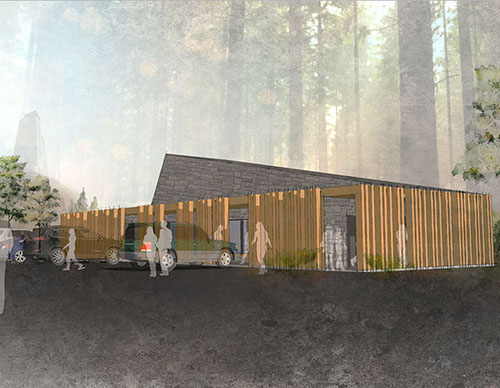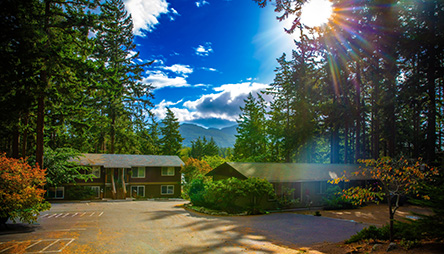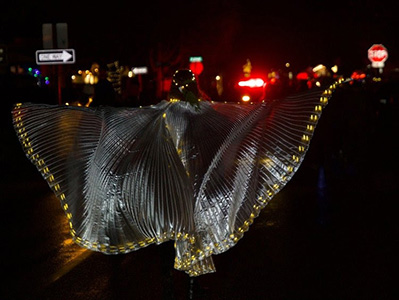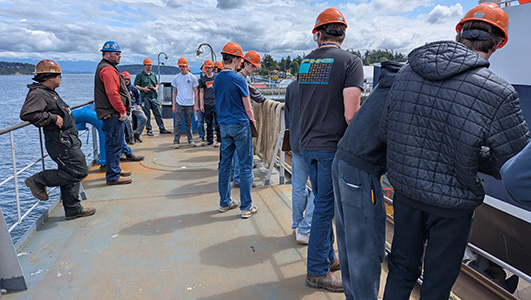— by Margie Doyle —

Design concept for interpretive center on existing concrete slab. (Restrooms will face the left side of the drawing.)
At a meeting on Thursday, Oct. 13 at the Orcas School Cafeteria, representatives from Washington State Parks and Patano Studio Architecture met with the public to discuss designs for new bathrooms and an interpretive center at the summit of Mount Constitution.
Derek Gustafson, Northwest Regional Capital Program Coordinator, emphasized that making the restrooms ADA- (Americans with Disabilities Act) compliant was the first order of business; and that cost considerations were foremost in keeping the slab/footprint of the current building at the summit. With those two primary charges, the State representatives and Chris Patano spent 75 minutes of the planned 90-minute presentation explaining their direction and process in designing the bathrooms and a yet-to-be-funded interpretive center.
Barbara Alten, Construction Project Coordinator said before the meeting, “In the future, we will be hosting a public meeting/startup design charrette for the Learning Center if we get the project funded by the legislature next July 2017. This [Oct. 13] meeting at the request of Friends of Moran was set up to address concerns about the direction of the design language for the summit.”
Friends Vice President Jackie Daigle pointed out in response that “Our next meeting on this project may not happen till the Learning Center itself is funded – the earliest being July 2017. By then, the new bathrooms, with the design featured above will have already been built.”
If the new Summit Learning Center is funded by the 2017 State Legislature, plans will go ahead to build a new interpretive center on the remaining 40 x 70 footprint. At the Oct. 13 meeting, the design firm director Chris Patano emphasized natural woods and stone, and the dominance of the Civilian Conservation Corps’ Tower at the top; however, many in attendance were disappointed in the plans shown.
The design plan, first presented to Moran State Park staff last June, calls for a “simple wood box with a wrap of rough-sawn vertical timbers to mimic the rhythm of surrounding forest,” said Patano. A stone veneer on the exterior, would be considered as an option, or “added alternate,” when costs and expenses are figured out. Adjacent to the restrooms, the interpretive center would have an angled, raised roof, with a window-skylight that would “frame” the CCC Observation Tower. Patano noted in his presentation, “This is by no means a final rendering of the building.”
Alex McMurray, Parks Historic Preservation Planner said, the remaining footprint would be “clearly a palette for something more,” i.e. interpretive center, a “big step and incredible asset for Moran State Park.” Washington State Parks has only 13 interpretive centers.
However, he cautioned that the interpretive center is “so far down the road. Our interpretation has to have some idea… but we face the challenge of designing/not designing the interior of a building that hasn’t been funded.”
With 10 minutes left before the scheduled meeting’s end, the public comment period was extended. Daigle read comments from community members who couldn’t be in attendance, and other community members spoke up.
Afterwards, Daigle said, “I was pretty disappointed with the meeting; we learned of the design this summer and it feels like our input is not being considered. It makes me wonder, who is the client? Who’s making the decision on this design? Moran State Park staff? Olympia?”
Daigle says she’d considered the new restroom-interpretive center “a fantastic opportunity,” and expected that the Friends of Moran StatePark would help in many ways, including some funding. However, “The design for the bathrooms may very well dictate the design of the Interpretive Center and we feel very strongly that the design as presented, is not congruent with the other buildings in Moran State Park. The public’s input really must be considered in earnest.
“Unfortunately, many questions were submitted and we have yet to see the answers. However, we remain hopeful that Friends of Moran State Park along with the local community, will have some influence on the ultimate design.”
Over 20 local stakeholders spent two full days in June on Orcas Island to “inform the planning process” for conceptual designs/themes for the interpretive displays that will eventually be showcased in the new Interpretive Center.
Meanwhile, Deception Pass Park has an Interpretive Center in the works as well that appears to fit in well with the other buildings in that park. They also recently built a restroom and office space in a design similar to the CCC buildings.To see the renderings for their interpretive center, go to: https://www.deceptionpassfounda
Background:
Daigle wrote earlier this month: “The approximately 40’ x 70’ structure was originally built to house radio equipment and some administrative functions for KVOS. Friends of Moran repurposed the building in 2009 when KVOS moved from analog to digital transmission and no longer needed the building. With the help of many volunteers and donations, Friends established a make-shift Summit Learning Center.
“This allowed visitors to the summit to come in from the cold and rain, get a complimentary cup of Local Goods coffee or tea and have their questions answered regarding geography, geology, hiking trails, etc. from our summer college interns and the summit hosts. Children at the summit enjoy taking a nature hunt or hiking with a loaner explorer backpack. In inclement weather, they can explore the center, which displays maps, books, posters and other learning tools and toys.”
Friends is looking into the feasibility of placing a temporary building on the bare slab until the new Interpretive Center is funded and built (best case scenario being 2017-2019). Daigle said, “Visitors to the summit still need their questions answered and a place to come in from the wind and rain.”
**If you are reading theOrcasonian for free, thank your fellow islanders. If you would like to support theOrcasonian CLICK HERE to set your modestly-priced, voluntary subscription. Otherwise, no worries; we’re happy to share with you.**







